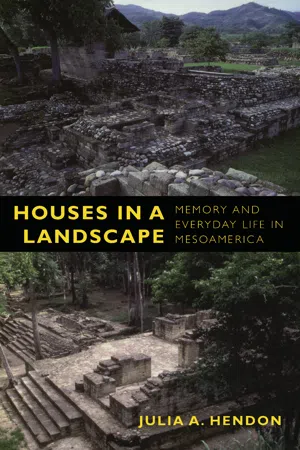
Houses in a Landscape
Memory and Everyday Life in Mesoamerica
- English
- PDF
- Available on iOS & Android
Houses in a Landscape
Memory and Everyday Life in Mesoamerica
About This Book
In Houses in a Landscape, Julia A. Hendon examines the connections between social identity and social memory using archaeological research on indigenous societies that existed more than one thousand years ago in what is now Honduras. While these societies left behind monumental buildings, the remains of their dead, remnants of their daily life, intricate works of art, and fine examples of craftsmanship such as pottery and stone tools, they left only a small body of written records. Despite this paucity of written information, Hendon contends that an archaeological study of memory in such societies is possible and worthwhile. It is possible because memory is not just a faculty of the individual mind operating in isolation, but a social process embedded in the materiality of human existence. Intimately bound up in the relations people develop with one another and with the world around them through what they do, where and how they do it, and with whom or what, memory leaves material traces.
Hendon conducted research on three contemporaneous Native American civilizations that flourished from the seventh century through the eleventh CE: the Maya kingdom of Copan, the hilltop center of Cerro Palenque, and the dispersed settlement of the Cuyumapa valley. She analyzes domestic life in these societies, from cooking to crafting, as well as public and private ritual events including the ballgame. Combining her findings with a rich body of theory from anthropology, history, and geography, she explores how objects—the things people build, make, use, exchange, and discard—help people remember. In so doing, she demonstrates how everyday life becomes part of the social processes of remembering and forgetting, and how "memory communities" assert connections between the past and the present.
Frequently asked questions
Information
Table of contents
- CONTENTS
- Illustrations
- Tables
- Acknowledgments
- Introduction. Thinking About Memory
- Chapter One. Communities of Practice in Honduras in the Seventh Century Through the Eleventh
- Chapter Two. The Enchantment and Humility of Objects
- Chapter Three. The Semiotic House: Everyday Life and Domestic Space
- Chapter Four. Embodied Froms of Knowing
- Chapter Five. Relational Identities and Material Domains
- Chapter Six. Special Events at Home
- Chapter Seven. Ballcourts and Houses: Shared Patterns of Monumentality and Domesticity
- Conclusion. Communities of Memory and Local Histories
- Notes
- Bibliography
- Index